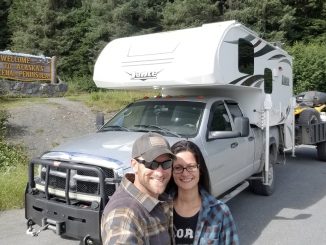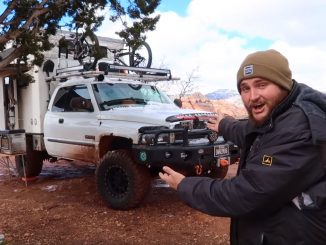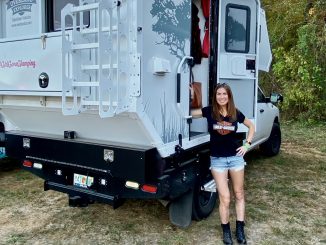
While the microwave oven isn’t exactly a rarity in today’s truck camper—especially large campers with one or more slide-outs—many off-grid enthusiasts abstained from the getting one not only because it reduces storage space inside the camper, but also because a generator is needed to run it. That was the thinking five years ago, perhaps, but not any longer. Employing light and powerful lithium batteries, now almost any truck camper with an appropriately sized inverter can run a microwave. That’s a good thing because the microwave oven can cook food and boil water exceptionally fast.
For years, we avoided having a microwave because it took up so much space. That changed, however, with the recent addition of our SherpTek truck bed, which added over 60 square feet of storage to our rig. Our camper already had a 360 amp hour lithium battery and a 3,000 watt inverter so we already had the power needed to operate one off-grid. We also had the perfect location in an overhead cabinet above the dinette where we could mount one.
Finding the right microwave for our truck camper wasn’t too difficult. The 14-inch depth of the overhead cabinet limited us to a small .7 cubic foot tabletop microwave rather than a large 1.1 cubic foot microwave typically found in large truck campers and RVs. The hardest decision was in the look of the microwave itself. Ultimately, we opted to go with black rather than stainless steel, because it matches the grey and black interior of the camper better. We decided to go with a Magic Chef HMM770W2, a .7 cubic foot countertop model. We bought ours at Home Depot for only $49.95, which is much less than an RV model with a trim kit. The unit weighs 20.5 pounds and measures 17 x 10 inches and is 12.5 inches deep. Don’t be misled by the wattage rating like we were at first. Even though our microwave is rated for 700 watts that is just the output, the input power needed to operate it is 1,050 watts.


Prepping the location for the microwave oven was fairly easy. The opening in the cabinet was perfect with about an inch extra of height and width with no additional cutting. After removing the flip-up door, an 18 x 13 inch piece of plywood was screwed the bottom of the cabinet to give the microwave the extra height needed to be centered in the opening. A board measuring 17 x 1 x 3 inches was used for bracing for the back, while a small 16 x 1/2 x 1/2 inch was used in the front to prevent the micowave from shifting forward or back during use or doing travel. Even though 120 volt power had already been run to that side of the cabinet, a simple modification was needed to relocate the outlet from facing underneath the cabinet to inside the cabinet in the corner. Two TV Grips mounting straps were used to secure the microwave to the plywood. Screws were used on the plywood side to give the mounting straps extra strength.
If you decide to go with a smaller countertop microwave oven, you won’t be able to find a trim kit that fits a .7 cubic foot model. We looked everywhere, but couldn’t find one. A custom frame needed be made, which we built out of cedar (a special shout-out goes to my brother-in-law, Lance Arave, who provided the tools, the know-how, and wood to make the frame). The four strips of cedar were milled to 1/2-inch x 1 inch with the outer edge routed to match the existing doors in the camper. We left a 1/8-inch gap along the inner edge of the frame for venting and to allow the microwave door to open and close freely. Additional venting was provided in two locations: one on the front and one on the bottom where the original 120 volt outlet was located. Two marine-grade VTurboWay louvers were used to cover the venting holes and to give the installation a professional look.
Overall, we’re pretty pleased with how the project turned out. The microwave makes meal prep so much faster and easier. While we were unable to find an appropriately-sized trim kit for our small microwave oven, we think our approach still looks good and provides an adequate amount of venting for the microwave oven to operate. Our camper’s Expion360 360 amp hour lithium battery and Xantrex 3,000 watt inverter provides more than enough power to operate it. As a matter of fact, operating it for 1 to 2 minutes drops the battery’s SOC only 1 to 2 percent. Sure, it takes up storage space inside the camper, but the microwave is still large enough to store things inside like bread and chips.


















Be the first to comment